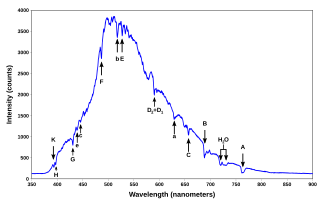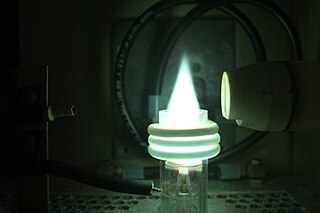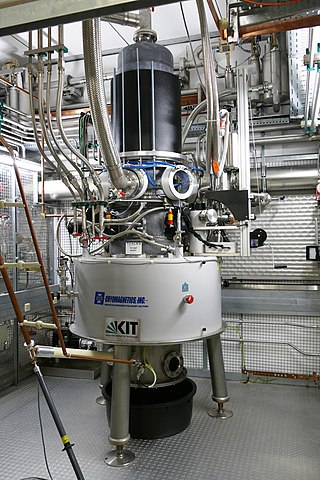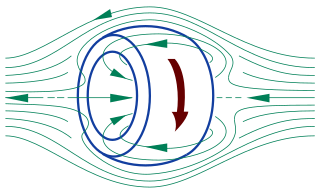External links
- GYRO Homepage at General Atomics Archived 2007-09-27 at the Wayback Machine
GYRO is a computational plasma physics code developed and maintained at General Atomics. It solves the 5-D coupled gyrokinetic-Maxwell equations using a combination of finite difference, finite element and spectral methods. Given plasma equilibrium data, GYRO can determine the rate of turbulent transport of particles, momentum and energy.

Nuclear fusion is a reaction in which two or more atomic nuclei, usually deuterium and tritium, combine to form one or more different atomic nuclei and subatomic particles. The difference in mass between the reactants and products is manifested as either the release or absorption of energy. This difference in mass arises due to the difference in nuclear binding energy between the atomic nuclei before and after the reaction. Nuclear fusion is the process that powers active or main-sequence stars and other high-magnitude stars, where large amounts of energy are released.

A spectral line is a weaker or stronger region in an otherwise uniform and continuous spectrum. It may result from emission or absorption of light in a narrow frequency range, compared with the nearby frequencies. Spectral lines are often used to identify atoms and molecules. These "fingerprints" can be compared to the previously collected ones of atoms and molecules, and are thus used to identify the atomic and molecular components of stars and planets, which would otherwise be impossible.
Plasma diagnostics are a pool of methods, instruments, and experimental techniques used to measure properties of a plasma, such as plasma components' density, distribution function over energy (temperature), their spatial profiles and dynamics, which enable to derive plasma parameters.
Professor Roger John Tayler OBE FRS was a British astronomer. Tayler made important contributions to stellar structure and evolution, plasma stability, nucleogenesis and cosmology. He wrote a number of textbooks. He collaborated with Fred Hoyle and Stephen Hawking at the University of Cambridge on problems of helium production in cosmology.

An inductively coupled plasma (ICP) or transformer coupled plasma (TCP) is a type of plasma source in which the energy is supplied by electric currents which are produced by electromagnetic induction, that is, by time-varying magnetic fields.

A gyrotron is a class of high-power linear-beam vacuum tubes that generates millimeter-wave electromagnetic waves by the cyclotron resonance of electrons in a strong magnetic field. Output frequencies range from about 20 to 527 GHz, covering wavelengths from microwave to the edge of the terahertz gap. Typical output powers range from tens of kilowatts to 1–2 megawatts. Gyrotrons can be designed for pulsed or continuous operation. The gyrotron was invented by Soviet scientists at NIRFI, based in Nizhny Novgorod, Russia.

A field-reversed configuration (FRC) is a type of plasma device studied as a means of producing nuclear fusion. It confines a plasma on closed magnetic field lines without a central penetration. In an FRC, the plasma has the form of a self-stable torus, similar to a smoke ring.
The Vlasov equation is a differential equation describing time evolution of the distribution function of plasma consisting of charged particles with long-range interaction, such as the Coulomb interaction. The equation was first suggested for the description of plasma by Anatoly Vlasov in 1938 and later discussed by him in detail in a monograph.
The diffusion of plasma across a magnetic field was conjectured to follow the Bohm diffusion scaling as indicated from the early plasma experiments of very lossy machines. This predicted that the rate of diffusion was linear with temperature and inversely linear with the strength of the confining magnetic field.

DIII-D is a tokamak that has been operated since the late 1980s by General Atomics (GA) in San Diego, USA, for the U.S. Department of Energy. The DIII-D National Fusion Facility is part of the ongoing effort to achieve magnetically confined fusion. The mission of the DIII-D Research Program is to establish the scientific basis for the optimization of the tokamak approach to fusion energy production.

Nuclear matter is an idealized system of interacting nucleons that exists in several phases of exotic matter that, as of yet, are not fully established. It is not matter in an atomic nucleus, but a hypothetical substance consisting of a huge number of protons and neutrons held together by only nuclear forces and no Coulomb forces. Volume and the number of particles are infinite, but the ratio is finite. Infinite volume implies no surface effects and translational invariance.
Winston H. Bostick was an American physicist who discovered plasmoids, plasma focus, and plasma vortex phenomena. He simulated cosmical astrophysics with laboratory plasma experiments, and showed that Hubble expansion can be produced with repulsive mutual induction between neighboring galaxies acting as homopolar generators. His work on plasmas was claimed to be evidence for finite-sized elementary particles and the composition of strings, but this is not accepted by mainstream science.
Gyrokinetic ElectroMagnetic (GEM) is a gyrokinetic plasma turbulence simulation that uses the particle-in-cell method. It is used to study waves, instabilities and nonlinear behavior of tokamak fusion plasmas. Information about GEM can be found at the GEM web page. There are two versions of GEM, one is a flux-tube version and the other one is a global general geometry version. Both versions of GEM use a field-aligned coordinate system. Ions are treated kinetically, but averaged over their gyro-obits and electrons are treated as drift-kinetic.
In mathematics, Maharam's theorem is a deep result about the decomposability of measure spaces, which plays an important role in the theory of Banach spaces. In brief, it states that every complete measure space is decomposable into "non-atomic parts", and "purely atomic parts", using the counting measure on some discrete space. The theorem is due to Dorothy Maharam. It was extended to localizable measure spaces by Irving Segal.
Gyrokinetics is a theoretical framework to study plasma behavior on perpendicular spatial scales comparable to the gyroradius and frequencies much lower than the particle cyclotron frequencies. These particular scales have been experimentally shown to be appropriate for modeling plasma turbulence. The trajectory of charged particles in a magnetic field is a helix that winds around the field line. This trajectory can be decomposed into a relatively slow motion of the guiding center along the field line and a fast circular motion, called gyromotion. For most plasma behavior, this gyromotion is irrelevant. Averaging over this gyromotion reduces the equations to six dimensions rather than the seven. Because of this simplification, gyrokinetics governs the evolution of charged rings with a guiding center position, instead of gyrating charged particles.
Physics Letters was a scientific journal published from 1962 to 1966, when it split in two series now published by Elsevier:
Jan M. Rost is a German theoretical physicist and director at the Max Planck Institute for the Physics of Complex Systems in Dresden heading the research department Finite Systems. He was awarded the status of Fellow in the American Physical Society, after nomination by the Division of Atomic, Molecular & Optical Physics in 2007, for seminal investigations of correlated doubly excited states, threshold fragmentation in few-body Coulombic systems and small clusters, pendular states of linear molecules, and for elucidating the role of correlation and relaxation in ultracold plasmas and Rydberg gases.
Tihiro Ohkawa was a Japanese physicist whose field of work was in plasma physics and fusion power. He was a pioneer in developing ways to generate electricity by nuclear fusion when he worked at General Atomics. Ohkawa died September 27, 2014, in La Jolla, California, at the age of 86.

John Holmes Malmberg was an American plasma physicist and a professor at the University of California, San Diego. He was known for making the first experimental measurements of Landau damping of plasma waves in 1964, as well as for his research on non-neutral plasmas and the development of the Penning–Malmberg trap.
The Fusion Pilot Plant is a program initiated in 2021 by the United States Department of Energy to construct a pilot plant capable of producing net electrical fusion power by the 2030s. In September 2022, $50 million was earmarked by the Department of Energy for development of a pilot fusion power plant. The National Academies of Sciences, Engineering and Medicine was involved in kicking off the program and advised it become a United States public-private partnership.